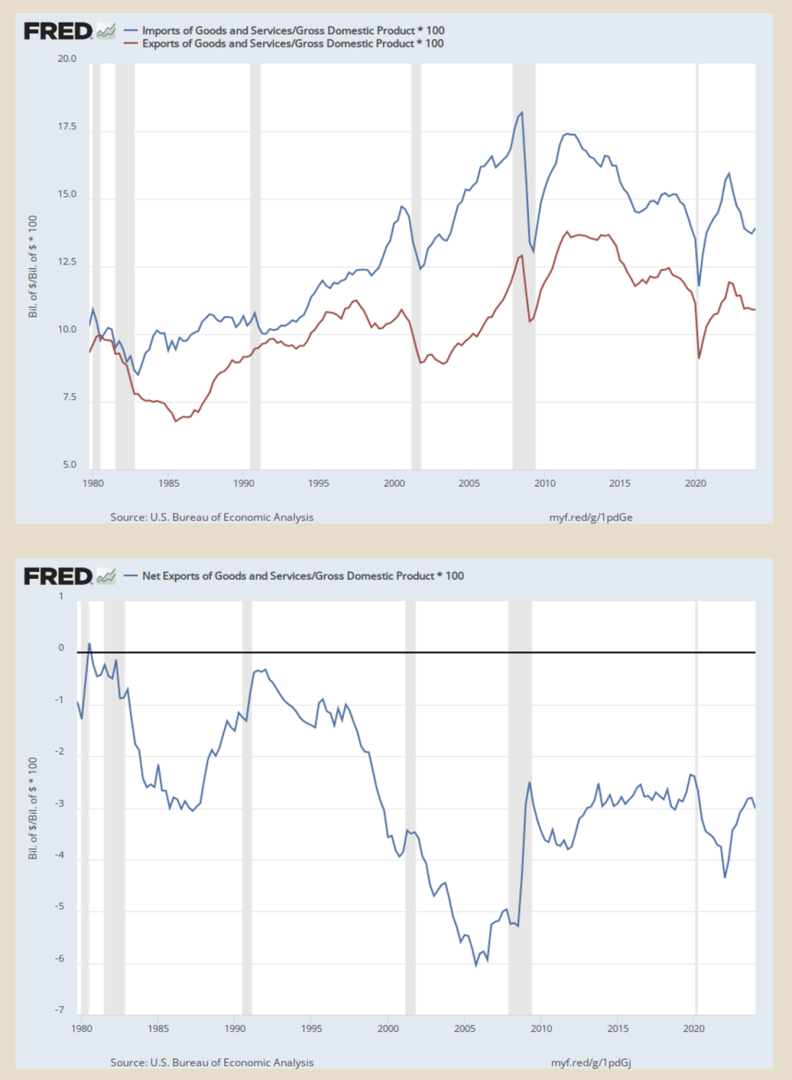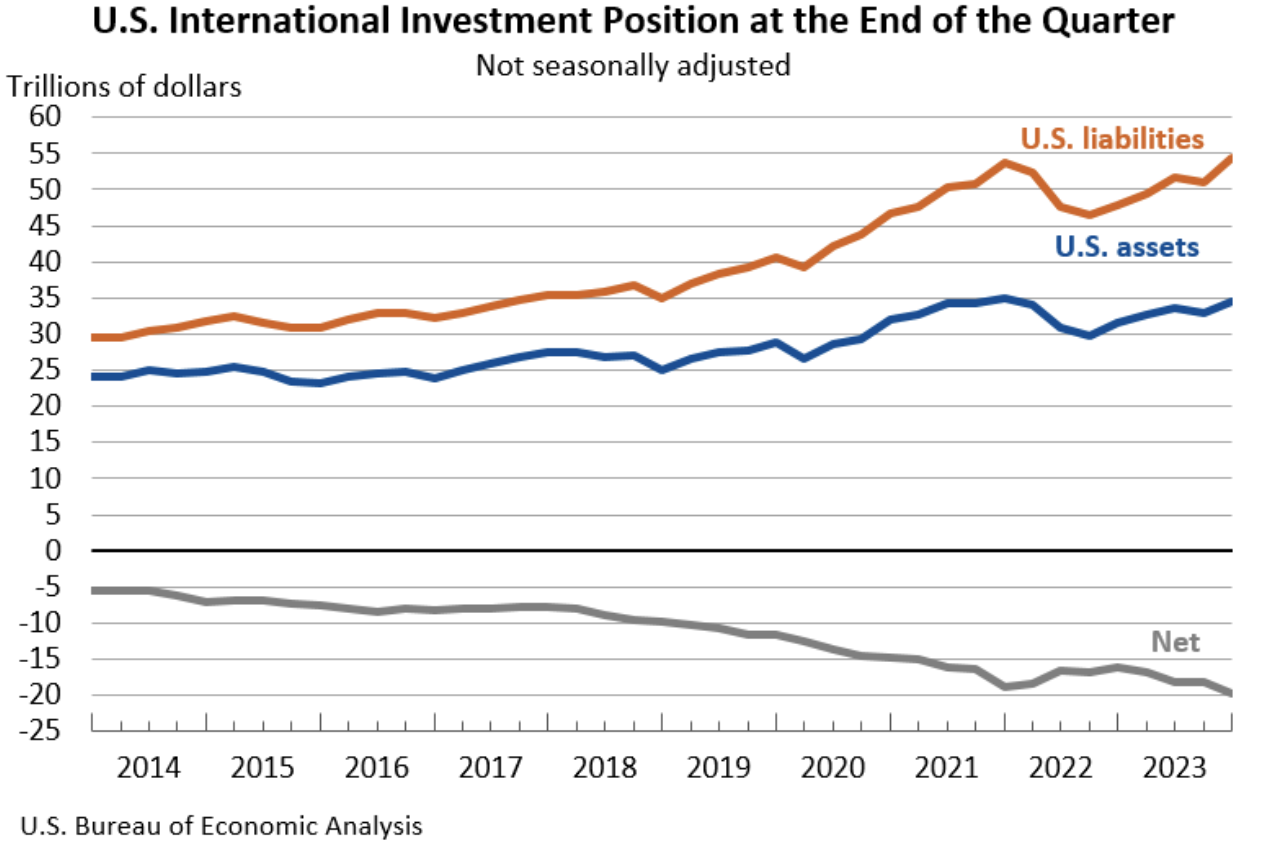
Trade Wars Are Easy to Win, and Income Tax is Easy to Eliminate
Many politicians and members of the public believe international trade is harmful to the US economy.
Consequently, they also believe that enacting high tariffs or other barriers to trade will benefit the US economy. The argument has been ongoing for centuries, and I have no illusions of resolving it here. But I can provide some facts bearing on two of the more outrageous claims.
For example, back in 2018, then-President Donald Trump tweeted: “When a country (USA) is losing many billions of dollars on trade with virtually every country it does business with, trade wars are good, and easy to win. Example, when we are down $100 billion with a certain country and they get cute, don’t trade anymore-we win big. It’s easy!”
President Trump used executive orders to enact higher tariffs and other barriers to trade, and on trade policy, President Biden has largely followed in the same footsteps. So has this trade war in fact been easy to win? The upper figure shows patterns of US imports (blue line) and exports (red line) since 1980, measured as a share of GDP. The lower level shows “net exports,” which is the gap between the two lines, which can be used as a measure of the US trade deficit.

Anyone with a morsel of curiosity might wonder: “We’ve had much higher tariffs since 2018 or so, in particular with China but with other parts of the world as well. But the trade balance hasn’t changed–if anything, it’s a little worse than it was. How can it be (one might wonder), that trade wars apparently aren’t so easy to win?
One obvious answer is that trade has many pathways through the world economy. Limits on direct trade with China can easily lead to China instead exporting to third countries (say, Vietnam), which then export to the US.
But the less obvious and more fundamental answer, taught in pretty much every intro econ class, is that a country’s balance of trade is not about whether other countries trade “fairly” or not. Looking at the trade deficit graph above, there’s no evidence that the up and down movements of the trade deficit track patterns of trade “fairness” by other countries. When the trade deficit got smaller in the second half of the 1980s or from 2005-2010, you didn’t see major headlines about “global fairness in trade improving.” That’s because trade balances are about big macroeconomic factors.
If the trade balance is zero, then the value of foreign currencies earned by US exporters is equal to the value of US dollars earned by those who sell imports to the US economy. If a country has a trade deficit, like the US, then the value of foreign currencies earned by US exporters must be less than the value of US dollars earned by those who sell imports to the US economy. If a country has a trade surplus, like China, then the value of foreign currencies earned by China’s exporters–including the US dollars they earn–must be greater than the value paid in renminbi yuan by China’s importers.
How is this imbalance possible? To put it another way, countries like China around the world are earning US dollars as the US economy imports goods and services from them. We know that these economies are not using all of those US dollars to purchase US exports–if they did, the US would not have a trade deficit. So what are they doing with those US dollars? The answer is that they are investing the US dollars in financial assets, including US Treasury debt.
The US Bureau of Economic Analysis keeps track of total US holdings of foreign assets, and total foreign holdings of US assets. Because of the trade deficit, the gap between these two, the “net international investment position” for the US economy, is steadily dropping (as shown in the figure).

Is it possible for the “net” line between US liabilities to foreign investors and the assets of US investors in foreign liabilities to keep declining? There’s some controversy here, but the answer seems to be “yes.” The reason is that foreign investors in the US economy tend to buy bonds, which on average pays a lower interest rate, while US investors in foreign economies tend to buy ownership of a company, which on average pays a higher interest rate. As a result, US investors who hold foreign assets, as a group, earn more than foreign investors who hold US assets, as a group (for detail on these arguments, see this post from 2021).
I fear for some readers that what I just wrote is a blur of words, and doesn't carry sufficient clarity. It’s easier to explain in about the sixth lecture of an intro macro course, when I’ve had a chance to lay some groundwork! But the bottom line is that trade deficits are a macroeconomic outcome, based on whether a nation consumes more than it produces, or not, and on the types of financial investments that happen in different economies around the world. Broadly speaking, the US has a trade deficit because runs its macroeconomy in such a way that it consumes more than it produces (for example, with large budget deficits), while China has a trade surplus because it produces more than it consumes (for example, by pressuring household to have extremely high rates of saving).
But set aside the question of whether it’s easy to use tariffs to “win” a trade war (as opposed to just starting a trade war). It turns out that Trump was “burying the lede” back in 2018, as the news-people say. According to Trump, higher tariffs can also allow the US to get rid of the US income tax! Perhaps this potential benefit of tariffs might have been mentioned back in 2018? But for this proposal, both the arithmetic and the economics are a mess.
The basic arithmetic is that personal income in the United States was about $23 trillion in 2023. The US income tax collected $2.2 trillion. This is roughly half of US federal revenue: the other half is mainly payroll taxes to support Social Security and Medicare and the corporate income tax, along with smaller sources like the federal excise taxes on gas, alcohol and tobacco, the estate tax, and others. Imports of goods and services in 2023 (the number behind what’s in the chart above) was $3.8 trillion.
A simple-minded calculation would suggest that if you tax $3.8 trillion at a tax rate of around 60%, you could raise the $2.2 trillion. But of course, imposing a tariff of 60% would lead to dramatically fewer imports, and so you would need to tax the remaining imports at a higher rate to collect that $2.2 trillion. Thus, this idea of using tariffs to offset the US income tax would surely require a tariff rate approaching 100%, or more.
Proponents of tariffs seem to think of them as a way of taxing foreign companies, without consequences for US households, but that belief is of course incorrect. Tariffs are essentially a form of a sales tax–a sales tax on imports. It would be possible to use revenue from a national sales tax (or a value-added tax) to replace the US income tax, but very few middle-income or low-income households would see that as a win, because they know that a higher sales tax leads to a higher purchase price at the cash register. Similarly, a 100% tariff on all imported oil, for example, would lead to a parallel increase in the price of gasoline.
Moreover, other countries would surely use higher US tariffs on their exports as a reason for imposing countervailing tariffs on US exports. In this scenario, firms and workers in US industries that depend heavily on the $3 trillion in US exports in 2023 (everything from farmers to pharmaceuticals) would see their global sales crater. The disruption to the US economy in this tit-for-tat tariff scenario would be dramatic at best, and depression-inducing at worst.
Again, I cannot hope to make the broader case for the benefits of international trade in a short post. But if you are left with grave doubts that tariffs are a useful way of reducing trade deficits and that tariffs can be a painless tool for eliminating the US income tax, my work for today is done.
Trending
-
1 UK Tech Sector Secures a Third of European VC Funding in 2024
Azamat Abdoullaev -
2 France’s Main Problem is Socialism, Not Elections
Daniel Lacalle -
3 Fed Chair Jerome Powell Reports 'Modest' Progress in Inflation Fight
Daniel Lacalle -
4 AI Investments Drive 47% Increase in US Venture Capital Funding
Felix Yim -
5 The Future of Work: How Significance Drives Employee Engagement
Daniel Burrus





Comments